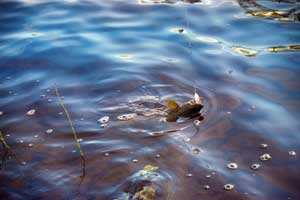Fishing Tackle – Spinners

A swivel is a must unless you want line tangles and twists on a regular basis. We recommend a ball-bearing swivel for the job.
Fishing spinners are seen as lures and also as an accessory to a lure or bait. It’s important to remember that spinners generate a lot of torque.
How Spinners work
- Spinners are simple devices that work by attracting fish using their sight and hearing senses
- They churn the water reflecting light and emitting a sonic sound that also catches the fish’s attention
Don’t be too concerned about the different colors and types. Just focus on the correct size and right swivel for the fish you’re hunting.
Blade Size and Shape
Size is important because of the effect you’ll get out of the blade. The wider and shorter the blade, the slower it will churn, with the inverse being true. This is because the blade’s surface area is directly correlated to water resistance. The larger the blade, the more the resistance and therefore the slower it churns.
Not all blades are smooth and symmetrical. Some blades have artifacts designed into them that alter the churning and sonic characteristics.
Platings and Finishes
There are numerous platings and finishes used on spinners. Platings include gold, silver, copper, brass and painted finishes.
Note:
- Light and bright finishes work best on bright days and in clear water
- On a cloudy day or in murky water, use a dull finish or the bright reflector will scare the fish away
Note: Sunlight will reflect of all sorts of surfaces on a sunny clear day including prey fish. However, on a cloudy day this is not normal and will spook the fish.
Choosing Spinners
The one thing to understand about choosing a fishing spinner is that it’s all about balance. Choose the appropriate size for the fish and keep the spinner in balance.
Swivel Spinners
A swivel spinner should be kept simple and just focus on the swivel and split ring.
Clevised Spinners
A clevis is a U-shaped piece of metal that gives the blade the room to rotate freely. The Clevis is often adorned with beads along the sides and serve to act as a bearing.
- Note: Avoid cheap clevis spinners as they easily bind.
Through-Blade Spinners
The blade doesn’t swing about the wire shaft on a clevis or swivel, but the shaft passes directly through a hole in the blade at one end.
The best known through-blade spinner is the Panther Martin.
Rotor-Blade Spinners
There are two types of rotor spinner baits with the most popular and recommended one being the double-wing version. The double wing version makes a more attractive sonic sound and works well partly due to its bell-shaped blade.
- Rotor-blade fishing spinners work well when fishing for bass
The bell-shaped blade procreates quite a lot of noise near the surface where it is useful and will cause a strike from a nearby fish. The winged drifter is a rotor blade lure and is best fished line using a sinker to keep it down. Use a float to keep it at the required depth.
This type of fishing can work well with steelheads when fished in their normal habitat.
Tandem Spinners and Cowbells
There are several different configurations from single to double spinners. The advantage of a single spinner is the torque elimination from the 2 mounted blades.
Bass, salmon and trout will strike at these lures when you use a cowbells lure or when you’re trolling in the lakes where these fish are found.
We recommend using a streamer or a cut bait with the trailing lure.



